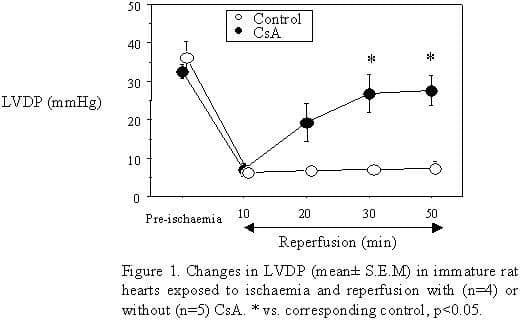Cyclosporin A (CsA) inhibits opening of the mitochondrial permeability transition pore (MPTP), a critical event in some forms of myocardial necrotic and apoptotic cell death, by binding to cyclophilin D and inhibiting its peptidyl-prolyl cis-trans isomerase activity (Halestrap et al. 2004). Unlike in adult heart, little is known about the MPTP activity and role in immature heart. In this study we investigated the effect of CsA on recovery following ischaemia and reperfusion in isolated perfused immature heart. Male Wistar rats (14 days old) were humanely killed, and the hearts were quickly removed, cannulated in the Langendorff mode and perfused with Krebs buffer at 37oC as described previously (Modi & Suleiman 2004). After 20 min equilibration, hearts were exposed to normothermic global ischaemia for 60 minutes. Hearts were then reperfused for 50 min and functional recovery determined. In the experimental group 0.2 μmol/l CsA was present 10 min before and during ischaemia, but was washed out after 20 min reperfusion. Left ventricular developed pressure (and computed heart rate) was measured using a balloon inserted in the left ventricle. All results are expressed means ± S.E.M. and analysed using ANOVA with Fischer’s PLSD post hoc test. During pre-ischaemic perfusion, CsA had no effect on heart rate or LVDP. Time to induce contractile arrest was similar for both groups (5.3 ± 0.2 vs. 4.4 ±0.5min for CsA and control, respectively). The time to onset of ischaemic contracture was also similar (10.1 ± 1.0 vs. 7.8 ± 1.1min). Upon reperfusion, CsA significantly improved % recovery in rate pressure product (mmHg. beats min-1) from 21% for control to 89%. Figure 1 shows time dependent change in LVDP in both groups. This work shows that the MPTP inhibitor CsA is cardioprotective when added to immature heart during ischaemia and reperfusion. The protection is likely to be associated with changes in mitochondria upon reperfusion rather than during ischaemic arrest.
University of Bristol (2005) J Physiol 567P, PC21
Poster Communications: The mitochondrial permeability transition pore inhibitor cyclosporin A protects the immature heart against ischaemia and reperfusion injury
Khan, Irfan H; Halestrap, Andrew P; Angelini, Gianni D; Suleiman, M. Saadeh;
1. Bristol Heart Institute, University of Bristol, Bristol, United Kingdom. 2. Department of Biochemistry, University of Bristol, Bristol, United Kingdom.
View other abstracts by:
Where applicable, experiments conform with Society ethical requirements.

